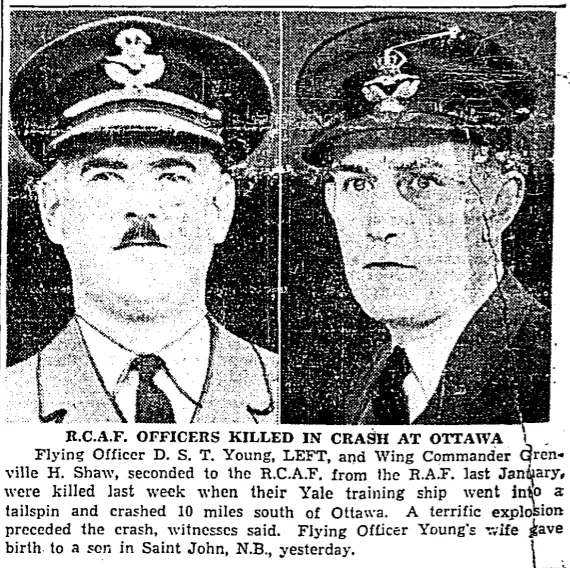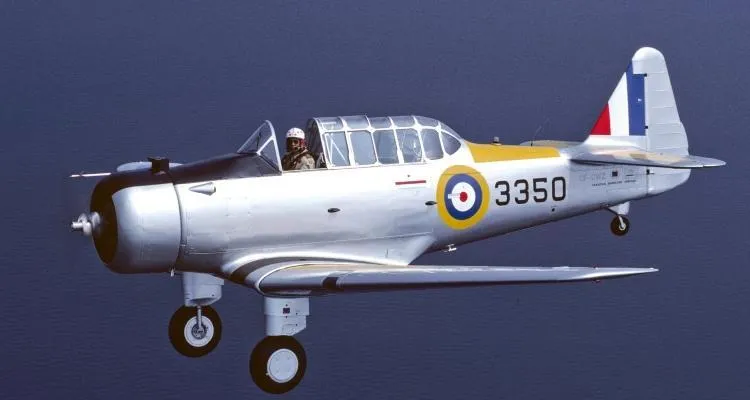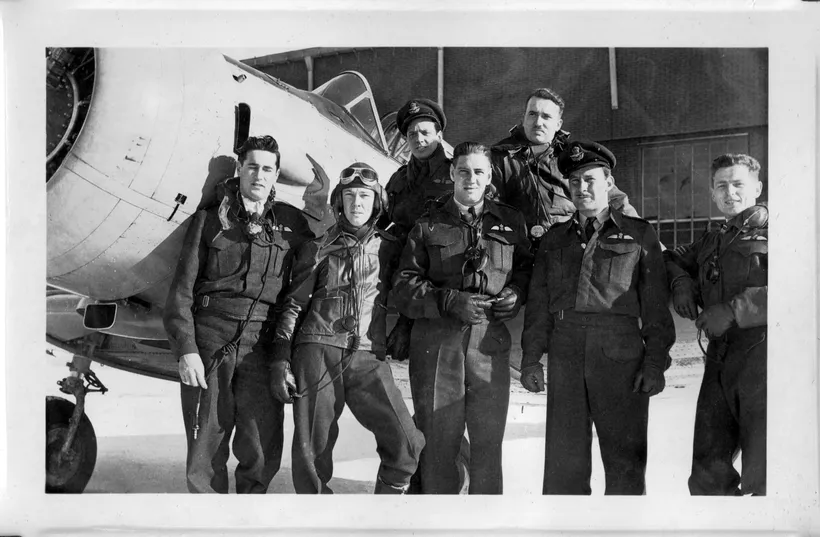Young, Donald Sidney Thomson (Flying Officer)
Killed in Flying Accident 1940-September-27


Birth Date: 1907-October-13
Born:
Parents: Son of Sidney Clarke Young and Grace Adeline Young, of Saint John; husband of Edna Clayton Young, of Saint John.
Spouse: Husband of Edna Clayton Young, of Saint John.
Home: St John, New Brunswick
Enlistment:
Enlistment Date: unkown date
Service
RCAF
Unit
2 SFTS- Service Flying Training School
Base
Uplands, Ottawa, Ontario, Canada
Rank
Flying Officer
Position
Pilot
Service Numbers
C/1806
Crew or Other Personnel
Yale 3431
Accident Card - North American Yale serial:3431
This accident involved 1 aircraft on 1940-September-27. Yale s/n 3431.
This accident involved 2 people. Shaw GH, Young DST
This accident had 2 fatalities. Flying Officer Donald Sidney Thomson Young RCAF Killed in Flying Accident service no:C/1806 Yale 3431, Wing Commander Grenville Hammerton Shaw RAF Killed in Flying Accident service no:22174 Yale 3431
Yale serial: 3431

The North American NA-64 (NA-64 P-2 or NAA-64 P-2 in French service, Yale in Canadian service) is a low-wing single piston engine monoplane advanced trainer aircraft that was built for the French Air Force and French Navy, served with the Royal Canadian Air Force, and with the Luftwaffe as a captured aircraft during World War II.
Ordered as a follow-on to the NA-57 as a two-seat advanced trainer, the NA-64 P-2/NAA-64 P-2 represented a major structural improvement, with a longer all-metal fuselage replacing the fabric covered fuselage of the NA-57. As well as metal skin replacing the fabric on the fuselage, the fin was changed from having a corrugated skin to being a smooth stressed skin structure and was moved slightly aft, lengthening the rear fuselage while the engine was moved forward to maintain the center of gravity. The rudder was also changed from the rounded shape used previously to one with a roughly triangular shape with the broadest part being at the bottom to improve handling at high angles of attack. In one respect however, it was a step backwards from its immediate predecessor, the BT-14, with which it is often confused, in that the earlier straight wings were used with the result that in RCAF service, when compared to the later and more powerful Harvard II it was flown alongside, it had different handling characteristics and lower performance.
The British Purchasing Commission bought the 119 aircraft that had not yet been delivered to France in 1940, and transferred them to the Royal Canadian Air Force (RCAF) for the British Commonwealth Air Training Plan between August and September 1940, and all were operational by November. The type was named the Yale Mk.I following British naming practice of naming trainers after education institutions and US-supplied aircraft after American locations, in this case, Yale University, and were used initially as intermediate pilot trainers taking pilots from the de Havilland Tiger Moth and Fleet Finch to the much faster and more complex North American Harvard, until this category was dispensed with as being unnecessary. They were then relegated for use as airborne wireless radio trainers, along with the contemporary Fleet Fort intermediate trainer in 1943. Prior to service entry, the throttle and engine mixture controls were modified from the system used by the French whereby the throttle was pulled back to increase power, and the mixture control pulled back to lean out the mixture, to the system used on the Harvard. Wikipedia
Aircraft Images
Yale 3431
Yale 3431
With No. 2 Service Flying Training School at Uplands, Ontario. Category A damage on 27 September 1940 at Uplands, when it failed to recover form an intentional spin. Crashed on aerodrome. Flying Officer D.S.T. Young and W/C G.H. Shaw, RAF killed.1940-09-23 Taken on Strength 2019-08-20
1940-September-27 Accident: 2 Service Flying Training School Loc: Uplands Ottawa Names: Shaw | Young
1940-12-14 Struck off Strength 2019-08-20
Unit Desciption
2 SFTS (2 Service Flying Training School)
Graduates of the EFTS "learn-to-fly" program went on a Service Flying Training School (SFTS) for 16 weeks. For the first 8 weeks the trainee was part of an intermediate training squadron; for the next 6 weeks an advanced training squadron and for the final 2 weeks training was conducted at a Bombing & Gunnery School. The Service schools were military establishments run by the RCAF or the RAF.
There were two different types of Service Flying Training Schools. Trainees in the fighter pilot stream went to an SFTS like No. 14 Aylmer, where they trained in the North American Harvard or North American Yale. Trainees in the bomber, coastal or transport pilot stream went to an SFTS like No. 5 Brantford where they learned multi-engine technique in an Airspeed Oxford, Avro Anson or Cessna Crane.
RCAF Station Uplands now the site of Ottawa International Airport CYOW.

For More Information on RCAF Station Uplands See here
RCAF.info - RCAF Station Uplands Ottawa Ontario
RCAF.info - Relief Landing Field Carp Ontario
RCAF.info - Relief Landing Field Edwards Ontario

